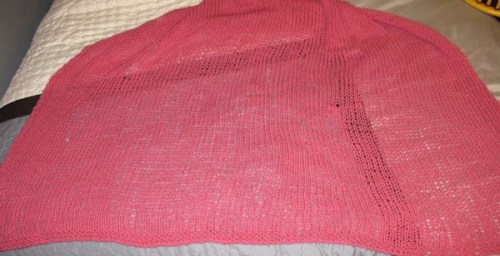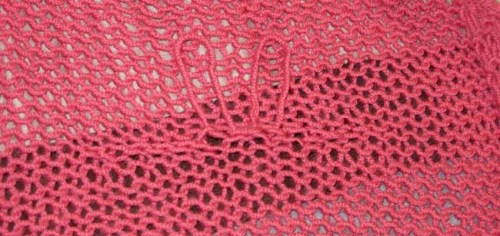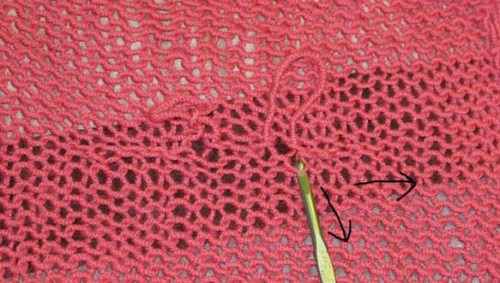For the Knifty Knitters, (or other brand of round loom users) – A shrug or wrap! Scroll down and see the note below about the delicateness of this garment before deciding to make one.
This is done with one strand of worsted weight yarn instead of 2 strands, (this yarn is the Caron One Pounder). This makes a garment that is looser and see-through, and has a lot of flounce, but still gives you warmth on days that are not too cold. It has the risky delicate factor mentioned below, but it also makes a nice feminine garment. If a Knifty Knitter is all you use, you may like the option of making a less thick garment with some swish.
How it’s made:
 With one strand of yarn, e-wrap all pegs except one on the largest knifty knitter loom, and keep going back and forth until its long enough. I leave that empty one because I work while watching tv, and this allows me to not accidentally connect the edges when I’m only half paying attention.
With one strand of yarn, e-wrap all pegs except one on the largest knifty knitter loom, and keep going back and forth until its long enough. I leave that empty one because I work while watching tv, and this allows me to not accidentally connect the edges when I’m only half paying attention.
Making the shrug: Go back and forth until it reaches from one wrist to the other (drape it behind you over your shoulders to check). Sleeves usually look best when they reach a little past the wrist as shown below, so shoot for this length. (Make sure it’s laying flat without the loom weight stretching it to get the length right.)
 A shrug is really nothing but a set of sleeves. After it’s long enough, bind off the edge. Roll it lengthwise with the inside out, and seam with the yarn in the spots shown below. (Pin it first and carefully try it on to make sure you get the seams a comfortable length.)
A shrug is really nothing but a set of sleeves. After it’s long enough, bind off the edge. Roll it lengthwise with the inside out, and seam with the yarn in the spots shown below. (Pin it first and carefully try it on to make sure you get the seams a comfortable length.)
 (You might notice my seams have stuff on them and holes, that’s because I didn’t make mine into a shrug, I just pinned it into place with hair clips to show you what it looks like if you want to make one.)
(You might notice my seams have stuff on them and holes, that’s because I didn’t make mine into a shrug, I just pinned it into place with hair clips to show you what it looks like if you want to make one.)
Making it into a wrap: To make it into a wrap instead of a shrug, don’t seam it, add fringe at the ends as if it were a scarf. I would suggest making it a little longer than wrist length. Mine is on the short side at shrug length. The ends of stockinette garments tend to want to roll, and the fringe helps pull it straight, especially after you wet it and let it dry. Using only one strand of yarn makes this garment very loose and swingy so there is less rolling.
The ends of stockinette garments tend to want to roll, and the fringe helps pull it straight, especially after you wet it and let it dry. Using only one strand of yarn makes this garment very loose and swingy so there is less rolling.
Delicateness! Unfortunately, any time you make something that is very loosely done (skinny yarn with big needles), the big holes in it put it at risk of getting pulls. You will have to be very careful with any garment done on a knifty knitter with only one strand of worsted weight yarn instead of the usual two. This means hold it up if you are around jumping dogs, keep it away from the cat, don’t put it in the dryer, and hand wash it. If it gets caught around a jean button or bra hook in the washer, it will get pulls and may be ruined.
Knifty Knitting thicker, with the usual 2 strands: You can probably make the shrug on the Knifty Knitter with the usual 2 strands of worsted yarn, but it will be thick and the sleeves will be very warm. The wrap likewise, you can do it, but it will be a VERY thick wrap, and not have the same “hang”. You are also more likely to have a problem with edge rolling on the sides and ends of a thicker wrap, or the sleeve ends of the shrug, so you might consider adding some purl stitches to the edges to help with that. or some crochet stitches. Loom e-wrap stitches are the same as “twisted knit” stitches. Here is a short youtube video which shows you how to do purl stitches on a loom: http://www.youtube.com/watch?v=MYFKncd7iDg
What to do about pulls: I would feel remiss if I did not include some info on repairing pulls, if they should happen. Sadly, they never seem to end up repaired quite like the original, so the best is really to protect the garment and not let them happen, but here’s some hope if they do.
 This is what my Rose Shrug looks like after a tryst in the washing machine. You can see some large holes in it. One loop gets caught on something, and a long string is pulled out.
This is what my Rose Shrug looks like after a tryst in the washing machine. You can see some large holes in it. One loop gets caught on something, and a long string is pulled out.
Attempted fix #1: On the left you can see an early attempt at fixing that, just by tying a knot in the long pull on the backside and cutting it off. It was quick, but doesn’t look right. Many nearby stitches are pulled too tight.
Attempted fix #2, on the right. Look at the anatomy of the pull (this is the back, or purl side). Below, you see that this one long loop can be followed several rows across on both sides where that one yarn was pulled tight (the tightness ends above my finger on the left and the same on the right).
So, get a crochet hook and pull the long yarn back to where it came from. First divide it in half evenly by following the yarn to the loop next door, and pulling half of it through that loop. Now you have two loops, one loop will get pulled to loosen the left and the other will go right.
 Keep following the yarn along its tightness in both directions, pulling the length through all of its tight loops. Try to give them the same looseness that they originally had.
Keep following the yarn along its tightness in both directions, pulling the length through all of its tight loops. Try to give them the same looseness that they originally had.
 The big loop will get shorter as you work it to the beginning point of the pull.
The big loop will get shorter as you work it to the beginning point of the pull.
 Here is the finished product after fix #2. It never seems to come out looking perfect. Perhaps with more careful trying.
Here is the finished product after fix #2. It never seems to come out looking perfect. Perhaps with more careful trying.
There is also always the option of tacking stuff on top of pulls to hide them, such as knit or crocheted flowers or butterflies. Depending on where the pull happens, this can wind up looking good if done in a yarn that is related or goes well with the garment. If you make the thinner wrap, you will probably want dainty flowers or butterflies done in a thinner yarn so that it doesn’t weigh it down.




